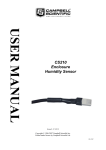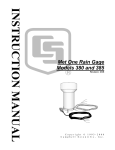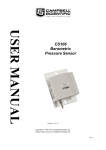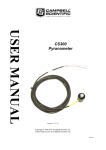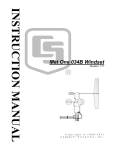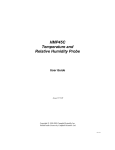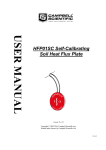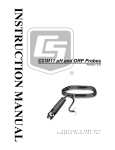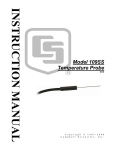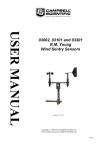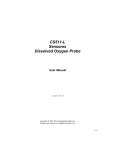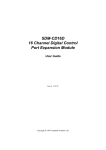Download Campbell CS100 Instruction manual
Transcript
CS100 Barometric Pressure Sensor Instruction Manual Issued 16.9.08 Copyright © 2002-2008 Campbell Scientific Inc. Printed under Licence by Campbell Scientific Ltd. CSL 533 Guarantee This equipment is guaranteed against defects in materials and workmanship. This guarantee applies for twelve months from date of delivery. We will repair or replace products which prove to be defective during the guarantee period provided they are returned to us prepaid. The guarantee will not apply to: • Equipment which has been modified or altered in any way without the written permission of Campbell Scientific • Batteries • Any product which has been subjected to misuse, neglect, acts of God or damage in transit. Campbell Scientific will return guaranteed equipment by surface carrier prepaid. Campbell Scientific will not reimburse the claimant for costs incurred in removing and/or reinstalling equipment. This guarantee and the Company’s obligation thereunder is in lieu of all other guarantees, expressed or implied, including those of suitability and fitness for a particular purpose. Campbell Scientific is not liable for consequential damage. Please inform us before returning equipment and obtain a Repair Reference Number whether the repair is under guarantee or not. Please state the faults as clearly as possible, and if the product is out of the guarantee period it should be accompanied by a purchase order. Quotations for repairs can be given on request. When returning equipment, the Repair Reference Number must be clearly marked on the outside of the package. Note that goods sent air freight are subject to Customs clearance fees which Campbell Scientific will charge to customers. In many cases, these charges are greater than the cost of the repair. Campbell Scientific Ltd, Campbell Park, 80 Hathern Road, Shepshed, Loughborough, LE12 9GX, UK Tel: +44 (0) 1509 601141 Fax: +44 (0) 1509 601091 Email: [email protected] www.campbellsci.co.uk PLEASE READ FIRST About this manual Please note that this manual was originally produced by Campbell Scientific Inc. primarily for the North American market. Some spellings, weights and measures may reflect this origin. Some useful conversion factors: Area: Length: 1 in2 (square inch) = 645 mm2 1 in. (inch) = 25.4 mm 1 ft (foot) = 304.8 mm 1 yard = 0.914 m 1 mile = 1.609 km Mass: 1 oz. (ounce) = 28.35 g 1 lb (pound weight) = 0.454 kg Pressure: 1 psi (lb/in2) = 68.95 mb Volume: 1 UK pint = 568.3 ml 1 UK gallon = 4.546 litres 1 US gallon = 3.785 litres In addition, while most of the information in the manual is correct for all countries, certain information is specific to the North American market and so may not be applicable to European users. Differences include the U.S standard external power supply details where some information (for example the AC transformer input voltage) will not be applicable for British/European use. Please note, however, that when a power supply adapter is ordered it will be suitable for use in your country. Some brackets, shields and enclosure options, including wiring, are not sold as standard items in the European market; in some cases alternatives are offered. Details of the alternatives will be covered in separate manuals. Recycling information At the end of this product’s life it should not be put in commercial or domestic refuse but sent for recycling. Any batteries contained within the product or used during the products life should be removed from the product and also be sent to an appropriate recycling facility. Campbell Scientific Ltd can advise on the recycling of the equipment and in some cases arrange collection and the correct disposal of it, although charges may apply for some items or territories. For further advice or support, please contact Campbell Scientific Ltd, or your local agent. Campbell Scientific Ltd, Campbell Park, 80 Hathern Road, Shepshed, Loughborough, LE12 9GX, UK Tel: +44 (0) 1509 601141 Fax: +44 (0) 1509 601091 Email: [email protected] www.campbellsci.co.uk Contents PDF viewers note: These page numbers refer to the printed version of this document. Use the Adobe Acrobat® bookmarks tab for links to specific sections. 1. Introduction .................................................................. 1 2. Specifications .............................................................. 2 2.1 Performance ............................................................................................. 2 2.1.1 Performance for “Standard” Range Option .................................... 2 2.1.2 Performance for “500 to 1100 mb” Range Option ......................... 2 2.1.3 Performance for “800 to 1100 mb” Range Option ......................... 2 2.2 Electrical .................................................................................................. 2 2.3 Physical .................................................................................................... 3 3. Installation .................................................................... 3 3.1 Venting and Condensation ....................................................................... 3 3.2 Mounting .................................................................................................. 3 4. Wiring ........................................................................... 4 4.1 Datalogger Connection............................................................................. 4 4.2 5-pin Screw Terminal Plug Connector ..................................................... 5 5. Programming ............................................................... 5 5.1 5.2 5.3 5.4 Conversion Factors .................................................................................. 6 Multipliers and Offsets for Different Measurement Range Options ........ 6 Program Examples ................................................................................... 7 Output Resolution .................................................................................... 9 6. Correcting Pressure to Sea Level .............................. 9 7. Maintenance and Calibration .................................... 10 Figures 1. CS100 Barometric Pressure Sensor............................................................ 1 2. CS100 as removed from the box and closeup of yellow warning label ..... 4 3. Connector Key Attached to 5-pin Screw Terminal Plug Connector .......... 5 Tables 1. 2. 3. 4. Signal and Ground Connectors for CS100 ................................................. 4 Conversion Factors for Alternative Pressure Units .................................... 6 Multipliers and Offsets ............................................................................... 6 Wiring for Example Programs ................................................................... 7 i CS100 Barometric Pressure Sensor 1. Introduction The CS100 is a capacitive pressure transducer that uses the Setra's electrical capacitor technology for barometric pressure measurements over the 600 to 1100 millibar range. The transducer’s compact and rugged polyester housing with stainless backplate contains two closely-spaced, parallel, electrically-isolated metallic surfaces. One of the surfaces is essentially a diaphragm constructed of a Setra’s proprietary compound of fused glass and ceramic (Setraceram™) or a low-hysteresis material, such as 17-4 PH SS. The diaphragm is capable of detecting a slight change in the applied pressure, which is then converted to an analogue voltage signal by Setra’s custom Application Specific Integrated Circuit (ASIC). The analogue signal generated by the barometer can be directly measured by a Campbell Scientific datalogger, such as 21X, CR7, CR500, CR510, CR10(X), CR23X, CR200 series, CR1000, CR3000, CR800, CR850, CR5000, and CR9000(X). The CS100 is supplied in the triggered mode, in which the datalogger switches 12 VDC power to the barometer before the measurement. The datalogger then powers down the barometer after the measurements to conserve power. Other measurement range options such as 500 to 1100 millibar, and 800 to 1100 millibar are also available. Please contact Campbell Scientific, Inc. for ordering these special versions. Figure 1. CS100 Barometric Pressure Sensor 1 CS100 Barometric Pressure Sensor 2. Specifications 2.1 Performance 2.1.1 Performance for “Standard” Range Option Measurement Range: Operating Temperature Range: Storage Temperature Range: Proof Pressure: Burst Pressure: Humidity Range: Media Compatibility: Resolution: Total Accuracy1: Linearity: Hysteresis: Repeatability: Long-term Stability: 600 mb to 1100 mb (hPa) -40°C to +60°C (-40°F to +140°F) -60°C to +120°C (-76°F to +248°F) 1500 mb 2000 mb non-condensing (up to 95% RH) non-corrosive, non-condensing air or gas 0.01 mb ±0.5 mb @ 20°C ±1.0 mb @ 0°C to +40°C ±1.5 mb @ -20°C to +50°C ±2.0 mb @ -40°C to +60°C ±0.4 mb ±0.05 mb ±0.03 mb ±0.1 mb per year 2.1.2 Performance for “500 to 1100 mb” Range Option Measurement Range: Total Accuracy2: Linearity: Hysteresis: Repeatability: 500 to 1100 mb ±0.6 mb @ 20°C ±1.2 mb @ 0°C to +40°C ±2.0 mb @ -20°C to +50°C ±2.5 mb @ -40°C to +60°C ±0.5 mb ±0.06 mb ±0.04 mb 2.1.3 Performance for “800 to 1100 mb” Range Option Measurement Range: Total Accuracy3: Linearity: Hysteresis: Repeatability: 800 to 1100 mb ±0.3 mb @ 20°C ±0.6 mb @ 0°C to +40°C ±1.0 mb @ -20°C to +50°C ±1.5 mb @ -40°C to +60°C ±0.25 mb ±0.03 mb ±0.02 mb Supply Voltage: 9.5 V to 28 Vdc 2.2 Electrical 1 The root sum squared (RSS) of end point non-linearity, hysteresis, nonrepeatability and calibration uncertainty. 2 The root sum squared (RSS) of end point non-linearity, hysteresis, nonrepeatability and calibration uncertainty. 3 The root sum squared (RSS) of end point non-linearity, hysteresis, nonrepeatability and calibration uncertainty. 2 Instruction Manual Current Consumption: Signal Output Warm-up Time: Response Time: Benefits: 3 mA nominal (operating mode) 1 µA quiescent (sleep mode) 0 to 2.5 Vdc <1 second from shutdown mode <100 msec Calibration NIST traceable Meets CE conformance standards 2.3 Physical Dimensions (Main Box): Weight: Mounting Hole Centres: Pressure Connector: NOTE 9.1 x 6.1 x 2.5 cm (3.6” x 2.4” x 1.0”) 135 g (4.8 oz) 7.62 cm (3 inches) 1/8” ID barbed fitting The black outer jacket of the cable is Santoprene® rubber. This compound was chosen for its resistance to temperature extremes, moisture, and UV degradation. However, this jacket will support combustion in air. It is rated as slow burning when tested according to U.L. 94 H.B. and will pass FMVSS302. Local fire codes may preclude its use inside building. 3. Installation 3.1 Venting and Condensation To prevent condensation, install the sensor in an environmentally protected enclosure, complete with desiccant, which should be changed at regular intervals. As the sensor must detect the external ambient pressure the enclosure must not be ‘hermetically sealed’. CAUTION Failure to protect the sensor from condensation may result in permanent damage. NOTE If it is necessary to make a vent hole on the outer wall of an enclosure, do not make the hole on one of the vertical side walls, as wind blowing around it can cause transient changes in pressure. 3.2 Mounting The mounting holes for the sensor are one-inch-centred (three inches apart), and will mount directly onto the holes on the backplates of the Campbell Scientific enclosures. Mount the sensor with the pneumatic connector pointing vertically downwards to prevent condensation collecting in the pressure cavity, and also to ensure that water cannot enter the sensor. 3 CS100 Barometric Pressure Sensor 4. Wiring 4.1 Datalogger Connection Before connecting the barometer to the datalogger, a yellow warning label must be removed from the pigtails (see Figure 2). The warning label reminds the user of the importance of properly connecting the barometer to the datalogger. Proper wiring is shown in Table 1. Yellow Warning Label Figure 2. CS100 as Removed from the Box Table 1. Signal and Ground Connectors for CS100 Wire CS106 Terminal Datalogger Single-Ended Measurement Datalogger Differential Measurement Blue VOUT S.E. Input High Side of Diff Input Yellow AGND AG (CR10(X), CR500, CR510) (Other Dataloggers) Low Side of Diff. Input Black GND (21X, CR7, CR9000(X)) G (Other Dataloggers) (21X, CR7, CR9000(X)) G (Other Dataloggers) Green EXT TRIG Control port (use to turn power on/off) Control port (use to turn power on/off) Red SUPPLY 12 VDC 12 VDC Shield Shield G (CR10(X), CR500, CR510) (Other Dataloggers) G (CR10(X), CR500, CR510) (Other Dataloggers) WARNING 4 Improper wiring may damage the CS100 beyond repair. Instruction Manual 4.2 5-pin Screw Terminal Plug Connector The datalogger connects to the CS100 via a 5-pin screw terminal plug connector. This connector is removable and may be replaced. The replacement connector may come with a connector key attached to it to ensure that the connector is plugged into the CS100 right side up (see Figure 3). When the connector is right side up, it will easily plug into the barometer. Figure 3. Connector Key Attached to 5-pin Screw Terminal Plug Connector WARNING A 5-pin screw terminal that is plugged in upside down will damage the sensor—perhaps beyond repair. 5. Programming The CS100 sensor is measured using the singled-ended voltage measurement instruction. Atmospheric pressure changes little with time. In most weather station applications measuring pressure once an hour is adequate. Program Example 1 is for the dataloggers that use the CRBasic language, such as CR200, CR800, CR850, CR1000, CR3000, CR5000, and CR9000(X). In the example, the CR1000 measures the CS100 once an hour in a program that runs at 1 Hz. In order to keep the CR1000 running in a pipeline mode, the measurement instruction is placed outside the “If” statement. The measurement is made every scan, and the measured value is first written into a temporary variable called "CS100_temp". Once the CS100 is turned on one minute before the hour, the CS100 starts to make the correct pressure measurements. At the top of the hour, the correct value is copied into the current variable called "pressure", and the sensor is turned off immediately. 5 CS100 Barometric Pressure Sensor In Program Example 2, the CR10X datalogger (Edlog datalogger) turns on the CS100 one minute before the top of the hour using a control port. On the hour the datalogger measures the CS100, and then it turns the CS100 off. 5.1 Conversion Factors In the example programs, the pressure is reported in millibars (mb). To report pressure in different units, multiply the measured pressure by the appropriate conversion factor using the P37 (Z=X*F) instruction for CR500, CR510, CR10(X), CR23X, 21X, and CR7, or by adding an expression for CR200, C800, CR850, CR1000, CR3000, CR5000, and CR9000(X) dataloggers. See Table 2 below for conversion factors. Table 2. Conversion Factors for Alternative Pressure Units To Find hPa kPa mm of Hg in of Hg Psi Atm Torr Multiply by 1.0 0.1 0.75006 0.02953 0.0145 0.00099 0.75006 5.2 Multipliers and Offsets for Different Measurement Range Options For CS100 barometric pressure transducers with measurement range options other than the standard 600 to 1100 mb option, please refer to the table below for proper multipliers and offsets. Table 3. Multipliers and Offsets Range Options 600 to 1100 mb (Standard range) 500 to 1100 mb 800 to 1100 mb 6 Multiplier 0.2 Offset 600 0.24 0.12 500 800 Instruction Manual 5.3 Program Examples The CS100 wiring instructions for the example programs are shown in Table 4 below. Table 4. Wiring for Example Programs Wire Colour Blue Red Black Yellow Green Clear Description VOUT – Pressure Signal Out SUPPLY – 12 Vdc Power In GND – Power Ground AGND – Signal Ground ETX. TRIG. – External Trigger Shield CR10(X) SE6 12V G AG C8 G CR1000 SE15 12V G C4 G Example 1. Sample Program for CR1000 (CRBasic) Datalogger 'CR1000 Datalogger Public CS100_temp Public pressure Units pressure = mbar DataTable (met_data,True,-1) DataInterval (0,60,min,10) Sample (1,pressure,IEEE4) EndTable BeginProg Scan (1,sec,3,0) ‘Measurement is made every scan outside the “If” statement VoltSe (CS100_temp,1,mV2500,15,False,200,250,0.2,600) ‘Turn on CS100 one minute before the hour If (IfTime (59,60,min)) Then WriteIO (&b1000,&b1000) ‘Copy the correct value to a current variable called “pressure” at the top of the hour ‘Turn off CS100 after measurement If (IfTime (0,60,min)) Then pressure = CS100_temp WriteIO (&b1000,&b0) EndIf CallTable met_data NextScan EndProg 7 CS100 Barometric Pressure Sensor Example 2. Sample Program for CR10X (Edlog) Datalogger ;{CR10X} ; *Table 1 Program 01: 1 Execution Interval (seconds) ;Turn on CS100 one minute before the hour ; 1: If time is (P92) 1: 59 Minutes (Seconds --) into a 2: 60 Interval (same units as above) 3: 48* Set Port 8* High ;Measure CS100 at the top of the hour ; 2: If time is (P92) 1: 0 Minutes (Seconds --) into a 2: 60 Interval (same units as above) 3: 30 Then Do 3: Volt (SE) (P1) 1: 1 2: 15 3: 6 4: 1 5: 0.2 6: 600 Reps 2500 mV Fast Range SE Channel Loc [ P_mb ] Multiplier Offset ;Turn off CS100 ; 4: Do (P86) 1: 58* Set Port 8* Low 5: End (P95) 6: If time is (P92) 1: 0 Minutes (Seconds --) into a 2: 60 Interval (same units as above) 3: 10 Set Output Flag High (Flag 0) 7: Real Time (P77) 1: 0110 Day,Hour/Minute (midnight = 0000) ;Store in high resolution mode to retain 0.01mb resolution ; 8: Resolution (P78) 1: 1 High Resolution 9: Sample (P70) 1: 1 2: 1* Reps Loc [ P_mb ] *Table 2 Program 02: 0.0000 Execution Interval (seconds) 8 Instruction Manual *Table 3 Subroutines End Program -Input Locations1 P_mb * Proper entries will vary with program and datalogger channel, and input location assignments. 5.4 Output Resolution When storing the values from the CS100 to a data table or to a datalogger’s final storage location, care must be taken to choose suitable scaling of the reading, or to store the value with adequate resolution to avoid losing useful resolution of the pressure measurement. The default resolution (low resolution) for Campbell Scientific dataloggers is limited to a maximum of four digits. Even then, the maximum digit value that can be displayed is 6999 for Edlog dataloggers, and 7999 for the CRBasic dataloggers. If you use this option with barometric data scaled in millibars (hPa), a reading above 799.9 mb for CRBasic dataloggers or 699.9 mb for Edlog dataloggers will lose one digit of resolution, e.g. at 900 mb, the resolution is limited to 1 mb. To retain 0.01 mb resolution, you either need to deduct a fixed offset from the reading before it is stored to avoid exceeding the 799.9 for CRBasic dataloggers or 699.9 for Edlog dataloggers threshold, or output the barometric reading in high resolution format. This can be done by using the IEEE4 format for the CR800, CR850, CR1000, CR3000, CR5000, and CR9000(X) dataloggers or using the Resolution (P78) instruction for our Edlog dataloggers. The default data output format for CR200 series datalogger is IEEE4. 6. Correcting Pressure to Sea Level The weather service, most airports, radio stations, and television stations reduce the atmospheric pressure to a common reference (sea level). Equation 1 can be used to find the difference in pressure between the sea level and the site. That value (dP) is then added to the offset (600 mb in our example programs) in the measurement instruction. U. S. Standard Atmosphere and dry air were assumed when Equation 1 was derived (Wallace, J. M. and P. V. Hobbes, 1977: Atmospheric Science: An Introductory Survey, Academic Press, pp. 59-61). ⎧⎪ ⎛ ⎞5.25328 ⎫⎪ E ⎬ dP = 1013.25 ⎨1 − ⎜1 − ⎟ ⎩⎪ ⎝ 44307.69231⎠ ⎭⎪ (1) The value dP is in millibars and the site elevation, E, is in metres. Add dP value to the offset in the measurement instruction. Use Equation (2) to convert feet to metres. 9 CS100 Barometric Pressure Sensor E(m) = E( ft ) 3.281ft m (2) The corrections involved can be significant: e.g. at 1000mb and 20°C, barometric pressure will decrease by 1.1mb for every 10 metre increase in altitude. 7. Maintenance and Calibration Since the sensor is semi-sealed, minimum maintenance is required: 1. Visually inspect the cable connection to ensure it is clean and dry. 2. Visually inspect the casing for damage. 3. Ensure that the pneumatic connection and pipe are secure and undamaged. The external case can be cleaned with a damp, lint-free cloth and a mild detergent solution. Contact Campbell Scientific Ltd before returning the sensor for recalibration. You may also return the unit directly to Setra for recalibration. Should you lose the five terminal connector the replacement part can be purchased from Campbell Scientific Ltd. CAUTION 10 The CS100 is sensitive to static when the backplate is removed. To avoid damage, take adequate anti-static measures when handling. CAMPBELL SCIENTIFIC COMPANIES Campbell Scientific, Inc. (CSI) 815 West 1800 North Logan, Utah 84321 UNITED STATES www.campbellsci.com [email protected] Campbell Scientific Africa Pty. Ltd. (CSAf) PO Box 2450 Somerset West 7129 SOUTH AFRICA www.csafrica.co.za [email protected] Campbell Scientific Australia Pty. Ltd. (CSA) PO Box 444 Thuringowa Central QLD 4812 AUSTRALIA www.campbellsci.com.au [email protected] Campbell Scientific do Brazil Ltda. (CSB) Rua Luisa Crapsi Orsi, 15 Butantã CEP: 005543-000 São Paulo SP BRAZIL www.campbellsci.com.br [email protected] Campbell Scientific Canada Corp. (CSC) 11564 - 149th Street NW Edmonton, Alberta T5M 1W7 CANADA www.campbellsci.ca [email protected] Campbell Scientific Ltd. (CSL) Campbell Park 80 Hathern Road Shepshed, Loughborough LE12 9GX UNITED KINGDOM www.campbellsci.co.uk [email protected] Campbell Scientific Ltd. (France) Miniparc du Verger - Bat. H 1, rue de Terre Neuve - Les Ulis 91967 COURTABOEUF CEDEX FRANCE www.campbellsci.fr [email protected] Campbell Scientific Spain, S. L. Psg. Font 14, local 8 08013 Barcelona SPAIN www.campbellsci.es [email protected] Campbell Scientific Ltd. (Germany) Fahrenheitstrasse13, D-28359 Bremen GERMANY www.campbellsci.de [email protected] Please visit www.campbellsci.com to obtain contact information for your local US or International representative.






















